Medicine:Gastric electrical stimulation
| Gastric electrical stimulation | |
|---|---|
 An impulse generator |
Gastric electrical stimulation, also known as implantable gastric stimulation, is the use of specific devices to provide electrical stimulation to the stomach to try to bring about weight loss in those who are overweight or improve gastroparesis.[1][2]
Gastric electrical stimulation is a pacemaker-like device with electrical connections to the surface of the stomach. The device works by disrupting of the motility cycle or stimulating enteric nervous system. There are a number of different devices on the market including Transend, Maestro, and Diamond.[1]
Medical uses
These devices are for treatment of gastroparesis. The best available evidence, however, find that they are of questionable utility for this condition.[2]
As of 2017 it is not approved for use for obesity in the United States.[3] The first studies done did not find a benefit, however, research is ongoing.[4]
Mechanism of action
Once food leaves the stomach and enters the duodenum, the gut-brain-liver axis is activated, which involves signaling between the gastrointestinal tract and the nervous system. For patients without type 2 diabetes, the gastric transit time of food is estimated to be 30–45 minutes (the time from food ingestion to food leaving the stomach into the duodenum). In type 2 diabetes, the neurohormonal communication system is impaired. Delayed signaling within the gut-brain-liver axis leads to high blood glucose concentration after meals.[5]
Usage
There are approximately 4,000 gastric pacer surgeries a year in the United States.
Approval
The Diamond system first received CE mark in 2007 and is approved for sale in Europe, Australia, and Hong Kong.[6] It is not approved in the United States for obesity.
References
- ↑ 1.0 1.1 Lebovitz, HE (March 2016). "Interventional treatment of obesity and diabetes: An interim report on gastric electrical stimulation.". Reviews in Endocrine & Metabolic Disorders 17 (1): 73–80. doi:10.1007/s11154-016-9350-7. PMID 27106829.
- ↑ 2.0 2.1 Levinthal, DJ; Bielefeldt, K (January 2017). "Systematic review and meta-analysis: Gastric electrical stimulation for gastroparesis.". Autonomic Neuroscience: Basic & Clinical 202: 45–55. doi:10.1016/j.autneu.2016.03.004. PMID 27085627.
- ↑ Choi, HS; Chun, HJ (January 2017). "Recent Trends in Endoscopic Bariatric Therapies.". Clinical Endoscopy 50 (1): 11–16. doi:10.5946/ce.2017.007. PMID 28147471.
- ↑ Chiu, JD; Soffer, E (January 2015). "Gastric electrical stimulation for obesity.". Current Gastroenterology Reports 17 (1): 424. doi:10.1007/s11894-014-0424-y. PMID 25613177.
- ↑ Burcelin, R (2010). "The gut-brain axis: A major glucoregulatory player". Diabetes Metab 36 (Suppl 3): S54–8. doi:10.1016/s1262-3636(10)70468-7. PMID 21211737.
- ↑ Israel21c. MetaCure treats diabetes without meds. http://www.israel21c.org/metacure-treats-diabetes-without-meds/ Accessed on November 30, 2015.
 |

